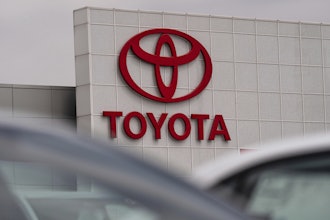
Exact
JobBOSS.
Shop management solutions.
MANUFACTURING
ERP SOFTWAR E
BUYERS GUIDE
A guide to selecting the right
shop management system.
jobboss.com
2 MANUFACTURING ERP SOFTWARE BUYERS GUIDE
What is shop management software?
Manufacturing shop management software is designed to increase
efficiency and productivity in the office and on the shop floor. It
contributes to key business initiatives by tracking detailed information
such as status of quotes and orders, inventory levels, on-time delivery
performance, employee efficiency, and work center capacity planning.
Business owners and shop floor managers use shop management
software every day to keep their fingers on the pulse of production
activity by having instant access to all aspects of the manufacturing
process. Order changes, work-in-progress management and
scheduling conflicts are easily accessible when shop management
software is used to provide visibility into all shop floor activity.
In essence, shop management software allows you to quote, process,
track and cost orders, manage material and outside services, enable
real-time labor tracking and efficiency reporting, schedule
production, and support your entire business with an integrated
accounting solution - all within an atmosphere of constant change.
CHOOSING THE RIGHT
MANUFACTURING
ERP (ENTERPRISE
RESOURCE
PLANNING) SYSTEM
ISN’T EASY
This Buyers Guide will assist you in objectively assessing ERP vendors and selecting
the right solution for your business today and wherever it takes you in the future.
MANUFACTURING ERP SOFTWARE
> Make-to-stock
> Assemble-to-order
> Make-to-order
> Mixed-Mode
MANUFACTURING ERP SOFTWARE BUYERS GUIDE 3
Quoting
Can your system quote multiple quantities
and automatically calculate pricing for new
parts without the need for a part/estimation
or engineering master?
Does your system have the ability to quickly
regenerate quotes on part history of similar
parts by allowing for the ability to copy from
previous jobs or work orders?
Can your system easily transfer a quote
directly to a job?
Processing the order
Can your system handle quick-run jobs,
blanket orders, complex assemblies, time
and material jobs and split jobs?
Can your system easily make changes when
a job is in process?
Can your system generate a shop traveler
automatically with all job requirements?
Business reason: Custom, make-to-order, make-to-stock, assemble-
to-order and mixed mode manufacturers need a system which
streamlines the quoting process and reduces the steps necessary
to create quotes for new work. Extra steps in the quoting process
increases the time required to respond to customer RFQs and may
hinder your ability to respond in a timely manner and win new work.
Business reason: Visibility to previous cycle times for similar parts is
critical to re-quoting work that is similar. Up-to-date part history at
your fingertips allows your company to instantly respond to customer
requests to quote similar parts.
Business reason: Creating work orders or jobs to manufacturer a
part is essential to reducing the time from receipt of order to release
to the shop floor. Efficient work order/job release is imperative to
shipping on time. Eliminating duplicate data entry is key.
Business reason: Job shops and custom manufacturers are known for
their ability to respond quickly to customer requirements. For many
shops, no two jobs are alike. The ability to generate different types
of work orders and easily split orders is imperative to increasing your
ability to respond to changing customer requests.
Business reason: The ability to make changes (with minimal effort)
when a job is in process supports your ability to quickly respond
to customer change requests. It can mean the difference between
shipping on time and losing future work because your shop cannot
respond quickly enough.
Business reason: Generating a shop traveler is key to manufacturing
the part correctly the first time. It provides all of the information
about the part in one consolidated packet with the ability to link the
latest part documentation including the latest revision of the part
right to the job. It will reduce the cost of rework and scrap.
SAMPLE QUESTIONS
TO ASK SOFTWARE
VENDORS
The following are actual questions from real RFPs submitted to JobBOSS by
manufacturers considering JobBOSS
4 MANUFACTURING ERP SOFTWARE BUYERS GUIDE
Scheduling the job
Can your system schedule by a job’s due
date, material availability, or work center
capacity and globally reschedule all jobs
based on actual job results?
Can your system easily let you view shop
loads vs. capacity?
Can your system generate dispatch reports
and isolate jobs running late?
Can your system automatically schedule
material purchases and outside series to a
job’s operation requirements?
Labor reporting
Does your system log all employee direct,
indirect and overtime hours against jobs?
Does your system easily track scrap and
rework and reason codes?
Can your system evaluate employee
performance?
Material control
Does your system provide full inventory
management for raw stock, hardware,
supplies and finished goods?
Does your system provide you with time-
phased material planning based on purchase
orders and work orders?
Can your system provide the flexibility to
either buy materials direct to a job or to
stock?
Can you view purchase history and stock
levels online with your system?
Business reason: Effective and flexible scheduling that can account
for material availability, current work center load, and actual job
performance when re-generating a schedule is crucial.
Business reason: This eliminates running your shop purely based “on
your gut” or intuition. It allows you to quickly isolate bottlenecks or
see available holes in the schedule where you can slot in more work.
Business reason: It reduces the time lost in the schedule not knowing
what to work on next. In addition, it can help to isolate jobs running
behind or running late so the shop foreman can react before it is too
late and while there is time to rectify the problem.
Business reason: It can help your shop reduce the cost of carrying
excess material as a safety buffer and increases the efficiency of
those who need to create purchase orders and is critical to lean
material management.
Business reason: It’s pretty simple. Direct hours make you money
and indirect/overtime hours could lose you money. Shop owners
and managers are often tasked with reducing direct to indirect labor.
Having a system that allows you quick visibility to direct, indirect
and overtime hours can help you better manage this key business
indicator.
Business reason: Reducing scrap and rework is a key lean initiative
and directly contributes to overall company profitability.
Business reason: Knowing which employees are most efficient doing
different types of work is critical to company profitability. Visibility to
inefficient employees allows you to also develop employee training
programs targeting specific reasons for that inefficiency.
Business reason:How a shop manages raw material and the visibility
of different sizes of the same type of raw stock is critical and can help
to eliminate excess purchasing.
Business reason: Managing your purchase of material to when it will
be consumed will typically save a shop 30-70% in additional carrying
costs.
Business reason: Visibility to commonly consumed material to
consolidate material purchases may in the end save you significant
dollars. Having a flexible system that allows you the visibility of
both direct buy material and inventory purchases is critical to take
advantage of these cost savings.
Business reason: Visibility to material requirements, purchase history,
and current stock levels allows you to better manage your material
levels, reduce expedite charges, and track those vendors who provide
you material at the best price on a consistently on-time basis.
MANUFACTURING ERP SOFTWARE BUYERS GUIDE 5
Shop view, shop stats, shop alerts
Does your system have an executive
dashboard that shows current business
information and activities?
Can you view customer, production, vendor,
and financial, statistics and data in one
place?
As events and changes occur, can your
system send pop-up alerts and instant
messages via email, mobile phone or pager?
Shipping the order
Does your system let you stay on top of
upcoming deliveries with delivery and
backlog reports?
Can your system handle over-shipments and
under-shipments?
Can your system track customer returns?
Can your system generate pack lists with
documentation to the customer?
Can your system analyze delivery
performance to improve on-time deliveries?
Analyze costs
Does your system let you know what every
job, with the ability to compare estimated
to actual labor, material and outside service
costs?
Can your system isolate problem jobs while
in process?
Can your system keep part history for repeat
jobs?
Business reason: CShop owners don’t have time to wait for data or
even to run a lot of reports every day to know the overall health of
the business. Visibility to those key business indicators that quickly
provide insight into which areas of the business are running well and
those areas that are not allows you to focus your energy on the areas
which need your attention.
Business reason: Customer, vendor, production and financial
performance are the key areas that directly impact a shop’s
profitability.
Business reason: Automatic notification increases awareness of job
status and can identify areas for improvement.
Business reason: Knowing which orders need to ship is critical for
maintaining the on-time delivery performance required by your
customers.
Business reason: Customers are constantly changing their delivery
requirements—sometimes right up until you ship.
Business reason: A key quality indicator for every shop is the number
of parts your customer returns. How you deal with the parts and
rectify the problem quickly and easily once they arrive is critical to
managing and maintaining customer satisfaction.
Business reason: Customer shipping requirements are as unique as
the customer. An incorrect pack list or shipping document could lead
to a return or a reject based on incorrect documentation and a delay
in invoicing and payment.
Business reason: On-time delivery performance is still a critical metric
for whether your customer awards you more work in the future.
Business reason: Because every job (sometime even for the same
part) may yield different results depending on who worked on the
job or the cost of material or outside service, it is critical to be able
to review actuals to estimates on each job and isolate those issues so
they are not consistently repeated.
Business reason: Visibility to projected costs before a job gets out
of control is imperative to managing a profitable manufacturing
business.
Business reason: Online part history quickly aids in re-quoting a
part (or similar parts) and allows for quick analysis of part cost and
profitability trends.
6 MANUFACTURING ERP SOFTWARE BUYERS GUIDE
Customer Relationship Management
(CRM)
Can your system organize and simplify
the process of managing customer
relationships?
Can your system identify top customers and
see pipeline quotes?
Can your system record customer
conversations, set follow-ups and manage
activities?
Automated workf low
Can your system automate your business
process from quote to cash?
Can your system immediately improve
efficiency, accountability, and compliance?
Does your system allow me to gain visibility
and control of my processes both within and
outside of manufacturing?
Total Quality Management (TQM)
Can your system manage my quality related
business processes?
Does your system meet ISO9000, Six Sigma,
and other unique industry and vendor-
specific regulatory requirements?
Integrate beyond job control
Can your system integrate with the following
applications?
SolidWorks
Microsoft Excel, Word, Access, SQL
QuickBooks
UPS WorldShip
Business reason: This helps maintain alignment between all the
aspects of the business including estimating, customer service,
and sales.
Business reason: Visibility to most profitable and most “growable”
customers is the foundation for current profitability. Nurturing new
potential customers helps to ensure future growth.
Business reason: Insight into every customer interaction ensures
activities are coordinated and correct expectations are set with the
customer.
Business reason: One of the reasons shop management systems
are so widely adopted is because of the ability to automate current
processes in order to streamline, adjust and improve communication
internally and with customers.
Business reason: Shop management software that enforces
standard business workflows offers immediate results and increased
accountability.
Business reason: Business issues may arise beyond the scope of
manufacturing and the shop floor. Visibility and control of these
business processes through automated workflows assures everyone is
on task and focused on those priorities which are critical to business
success.
Business reason: Total Quality Management helps to reduce risk
through visibility and control of quality issues throughout the
manufacturing process.
Business reason: Your customers are requiring compliance to
ISO, AS9100, FDA, and other industry quality initiatives. A quality
management system integrated with your shop floor system
provides your company seamless control and management of these
compliance and risk initiatives.
Business reason: Manufacturers today utilize different solutions to
control unique aspects of their business. Your shop floor management
solution should seamlessly integrate with these applications to reduce
data entry errors, reduce duplication of effort and increase efficiency.
MANUFACTURING ERP SOFTWARE BUYERS GUIDE 7
Pricing,implementation, service &
support
Can you prove full transparency of pricing
and any additional costs that may be
incurred from implementing a shop
management solution, including but not
limited to, training, support, etc.?
Do you provide a dedicated customer
advocate and training program to help go
live?
Do you have an online support and best
practices center? Can other product users
contribute? Is it monitored by a staff
member?
Please provide a typical timeline for
implementation?
Can you provide details of any available,
optional services that your company
provides?
How frequently does your company have
new product releases and how is training
done on new features and functionality?
Business reason: Transparency of pricing means shop owners/
managers can budget more effectively and won’t be surprised with
unexpected costs after the initial sale.
Business reason: A dedicated customer advocate aids in short
implementation time, meaning shop owners/managers can get up
and running quickly for fast results.
Business reason: A valuable web self-service area is essential to
getting the most out of the product, accessing helpful resources, and
interacting with experts and customers.
Business reason: The faster you implement shop management
software, the faster you can achieve ROI on your purchase.
Business reason: Services will help you make the most of your shop
management tool when moving past the basics, or when you need
business process help.
Business reason: Shop management software is an evolving
technology. Your company should be able to take advantage of all
features of the shop management solution and be communicated
regularly via multiple communication options, such as email, phone,
customer portal posting, etc.
Every shop management system demo will be a little different. Regardless of
the path the salesperson takes, make sure the system you select makes you feel
confident about these seven critical areas.
WHAT TO LOOK FOR IN
A MANUFACTURING
ERP DEMO
1) I can easily create customer quotes, enter orders, track labor, manage outside services,
and track material costs with this integrated solution.
2) I have all the functionality I need today, but still have plenty of room for growth.
3) This system will give me visibility to which types of orders make money and which ones
do not.
4) My employees will be able to improve their efficiency and be more accountable.
5) My customers will see improved on-time delivery performance and improved product
quality because of this system.
6) I saw ways to automate my shop’s manual processes, reduce duplicate data entry and
felt confident this system provides the structure and control to manage my business.
7) I have options for both cloud and on-premise software, and can choose the right solution for
my business.
MANUFACTURING ERP SOFTWARE BUYERS GUIDE 9
REMOTE HOSTED
VS. ON-PREMISE
SOFTWARE
The use of hosted or cloud software is showing strong and consistent growth. Cloud
computing – an umbrella term for a wide range of online services – is an attractive option for
small and medium sized businesses (SMB) manufacturers seeking to make the most of
current technology at lower costs and lower risk. With a low-cost monthly subscription and
hosted software, the upfront investment in software / hardware and low, licensing and
renewal costs are kept to a minimum.
SMB manufacturers are often faced with the dilemma whether they should go for a hosted or
an on-premise solution. There is really no right or wrong answer but companies need to
assess their business needs and infrastructure before taking a decision. There are
advantages and disadvantages with both platforms. The quick reference guide below
outlines the pros and cons of both hosted and on-premise delivery models.
Platform Benefits On-Premise Software Hosted Software / Subscription
Buy vs. Subscribe You own the software. One-time, up-front payment plus annual maintenance fee
Flexible monthly subscriptions. Ongoing
monthly payments with maintenance
included
Cost Lowest total cost of ownership Lowest monthly cost
Payment Purchase with 30-90 day terms Automated credit card billing
TCO Lowest total cost of ownership Lowest initial cost of ownership
User Model Concurrent seat licensing
Implementation Implementation takes time and planning No hardware or software installation. Hosted on the cloud
Hardware You own and maintain hardware and IT systems Any internet able device
Security Your IT staff monitors data security and back-ups Data security and back up ensured by vendor
User Access Software installed on every PC Web browser
Connectivity
You are responsible for internet connectivity and your company intranet for integration
with: - Non-hosted/SaaS software utilized on premise (i.e. Office, nesting, CAD)
- Hardware utilized for business operations (i.e. printers, labelers)
IT Operations and
Maintenance
Running and updating the system is in your hands
No need to maintain the system, vendor
handles updates and enhancements
Scalability Easily add seat licenses Easily add seat licenses
Balance Sheet A depreciable capital expense Not a capital expense
Accessibility
Connectivity to the intranet is determined by the
company
Accessible 24/7. For use on many devices,
anywhere, anytime






















